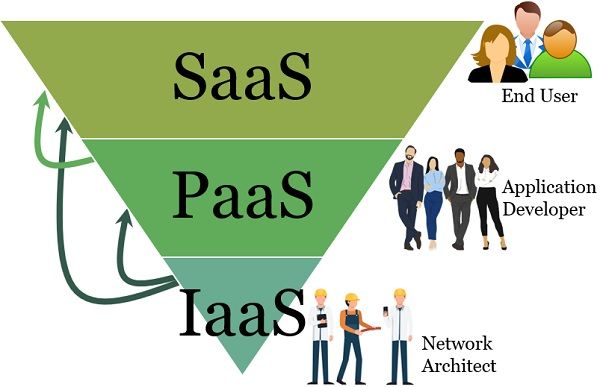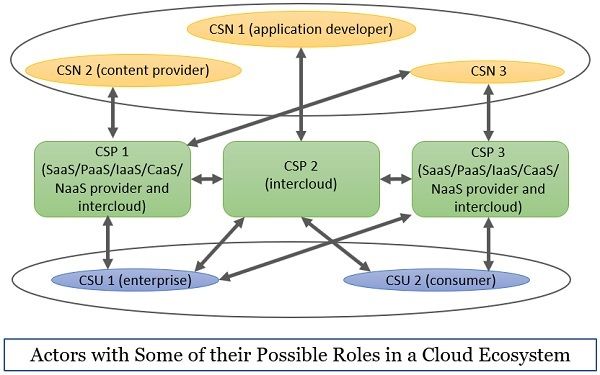Studying the cloud ecosystem will help you determine the environment of the cloud system. The environment consists of interrelated components. These components work in collaboration to facilitate cloud services. The services offered by the cloud ecosystem include infrastructure (IaaS), platform (PaaS), and software (SaaS).
However, the cloud ecosystem is not simple. Instead, it is a complex system that describes each and every entity within the environment. Also the interaction between these entities. The system also details about the stakeholders like:
- Cloud engineers that resolve your cloud issues.
- Cloud customers that consume the cloud services.
- Third parties
- Integrators
- Partners, etc.
In the section ahead will we discuss more about the cloud ecosystem.
Content: Cloud Ecosystem
How Does Cloud Ecosystem Work?
The core of the cloud ecosystem is the public cloud service provider. It can either be an infrastructure provider (IaaS) such as Amazon Web Services (AWS). It can be a software provider (SaaS) such as Salesforce, Microsoft, etc.

The outer of the ecosystem are the high-tech software companies that use the anchor platform of the service providers. Such as Engine Yard, Google Cloud, etc. The outer of the cloud ecosystem also includes consultants or companies that form a strategic alliance with the anchor platform provider.
The companies in the ecosystem keep on overlapping each other so there is no vendor lock-in condition in the cloud ecosystem. For example, consider Amazon Web Services which has its own ecosystem that provides infrastructure services. Now it is also part of the Salesforce ecosystem. As we know salesforce provides software services, but the maximum of these services runs on AWS.
The cloud ecosystem is so powerful that its customer can easily purchase business applications to cope up with the changing business requirement. In case the service that the customer wants to purchase is sold out then the customer can view the catalogue of different vendors whose services are verified and reviewed for the factors such as security, risk and cost.
Actors of Cloud Ecosystem
The actors of this ecosystem can either be one who is providing the cloud services or the one who is consuming the cloud service. The sections below will provide you with the detail of every actor in the system.
Cloud Service Users (CSUs)
The actors in the ecosystem who consumes the cloud services are cloud service user. Now it can either be an individual or the whole enterprise. The enterprises can either be private or governmental. The cloud service users can even be the intermediary agents that further deliver the cloud services to the end-users that are provided to them by cloud service providers. The end-user of the cloud services could be a person, application or instead a machine.
Cloud Service Providers (CSPs)
A cloud service provider is actually an organization that delivers cloud services to cloud service users. CSPs are also responsible for maintaining and managing cloud services.
Cloud Service Partners (CSNs)
The cloud service partners can either be individual. Or instead, an organization that supports building the services that the cloud service providers offer. The CSNs could either be application developers, system integrators, software or hardware provider or auditor etc.
The figure below shows you the actors of cloud computing and their interaction with each other.
Examples
Example 1
If you observe around yourself there are several examples of cloud ecosystems. One such example is a popular cloud accounting solution, Tally. It provides software as a solution that assists in accounting and integrating payroll solutions. The ecosystem of Tally can even collaborate with the third-party CSPs that offer additional features to this accounting software such as:
- Reporting tools
- Dashboards
- Work paper
- Workflow
- Project management
- Customer Relationship Management (CRM)
Example 2
Even Amazon Web Services (AWS) is one of the most popular and evolving cloud ecosystems. It provides infrastructure as a service. AWS is composed of several cloud management vendors. Using this great ecosystem, evolving companies can build new business models.
Example 3
IBM is also the most know cloud ecosystem. It offers the services such as IaaS, PaaS and SaaS through the public, private and hybrid cloud delivery models.
Benefits
The cloud ecosystem helps many companies to construct a new business model. For example, consider that there is a device manufacturer that manufactures heart monitoring machines. Besides this business, he can launch software that provides heart monitoring services.
Now the manufacturer can run the software on its cloud provider’s infrastructure. So, the manufacturer is now able to sell this service (SaaS) along with his main business of manufacturing heart monitors for hospitals.
With a cloud ecosystem, it becomes easier to aggregate data and identifies the trends in the data. For example, consider that there are many SaaS services related to the medical field that gathers information such as:
- Patients records
- Healthcare providers records
- Smart device logs
All of this data helps the evolving companies to analyze the pattern across the entire population of patients. This will again benefit them in launching new business models.
It even helps in analyzing how the components of cloud systems are interdependent on each other.
So overall we can say that the cloud ecosystem defines each entity present in the system along with its usage and its value in the system. All the entities together in the ecosystem can enable users to have integrated the best solutions for their problems.


Leave a Reply